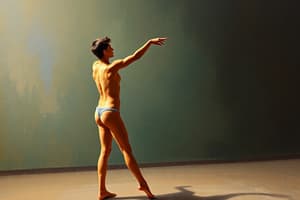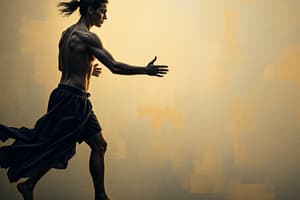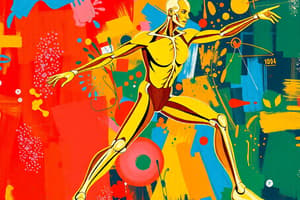Podcast
Questions and Answers
Which factor is NOT explicitly identified as influencing human movement within the scope of Human Movement Studies (HMS)?
Which factor is NOT explicitly identified as influencing human movement within the scope of Human Movement Studies (HMS)?
- Physiological
- Economic (correct)
- Mechanical
- Psychological
A 'discipline' within Human Movement Studies (HMS) is primarily focused on the practical application of knowledge to improve societal well-being.
A 'discipline' within Human Movement Studies (HMS) is primarily focused on the practical application of knowledge to improve societal well-being.
False (B)
Match the following characteristics with either a 'Discipline' or a 'Profession' within Human Movement Studies (HMS):
Match the following characteristics with either a 'Discipline' or a 'Profession' within Human Movement Studies (HMS):
Systematic study = Discipline Providing services based on expertise = Profession Theoretical foundation = Discipline Commitment to helping others = Profession
Which of the following is NOT a typical profession directly based on Human Movement Studies (HMS)?
Which of the following is NOT a typical profession directly based on Human Movement Studies (HMS)?
Within the biological influences on movement, the process of becoming mature, getting older, and overall _______ are included.
Within the biological influences on movement, the process of becoming mature, getting older, and overall _______ are included.
Which of these parent disciplines contributes the LEAST to the foundation of Human Movement Studies (HMS)?
Which of these parent disciplines contributes the LEAST to the foundation of Human Movement Studies (HMS)?
Sport History, as a sub-discipline of HMS, primarily focuses on the physiological adaptations of athletes to high-intensity training.
Sport History, as a sub-discipline of HMS, primarily focuses on the physiological adaptations of athletes to high-intensity training.
Which sub-discipline of HMS is most directly concerned with the ethical implications and conceptual analysis within sports?
Which sub-discipline of HMS is most directly concerned with the ethical implications and conceptual analysis within sports?
Name one way that studying the historical foundations of social welfare can help future human service professionals.
Name one way that studying the historical foundations of social welfare can help future human service professionals.
Which historical development significantly shaped social welfare, moving it away from familial responsibility?
Which historical development significantly shaped social welfare, moving it away from familial responsibility?
The Elizabethan Poor Laws of 1601 considered all poor individuals as equally deserving of assistance.
The Elizabethan Poor Laws of 1601 considered all poor individuals as equally deserving of assistance.
What was a key response to the social issues that arose during the Industrial Revolution?
What was a key response to the social issues that arose during the Industrial Revolution?
The Charity Organization Societies (COS) marked the emergence of social work by introducing _______.
The Charity Organization Societies (COS) marked the emergence of social work by introducing _______.
What fundamental shift in perspective did the Settlement House Movement bring to the understanding of poverty?
What fundamental shift in perspective did the Settlement House Movement bring to the understanding of poverty?
The Beveridge Report (1942) advocated for a welfare system based primarily on charitable giving.
The Beveridge Report (1942) advocated for a welfare system based primarily on charitable giving.
In apartheid-era South Africa, which group primarily supported welfare for Black Africans?
In apartheid-era South Africa, which group primarily supported welfare for Black Africans?
Name one focus area in the White Paper on Social Welfare (1997) in post-apartheid South Africa.
Name one focus area in the White Paper on Social Welfare (1997) in post-apartheid South Africa.
Match the philosophy with the focus in relation to Physical Education:
Match the philosophy with the focus in relation to Physical Education:
Which of the following is one of the 'three learning domains' related to the objectives of Physical Education?
Which of the following is one of the 'three learning domains' related to the objectives of Physical Education?
Flashcards
What is Human Movement Studies (HMS)?
What is Human Movement Studies (HMS)?
The systematic and scientific study of how and why people move, including psychological, physiological, mechanical, and social factors.
Discipline (in HMS)
Discipline (in HMS)
An organized body of knowledge that describes, explains, and predicts phenomena.
Profession (in HMS)
Profession (in HMS)
A specialized occupation improving societal well-being by providing services based on expertise.
Influencing Factors on Movement
Influencing Factors on Movement
Signup and view all the flashcards
Exercise Physiology
Exercise Physiology
Signup and view all the flashcards
Sports Medicine
Sports Medicine
Signup and view all the flashcards
Sport Biomechanics
Sport Biomechanics
Signup and view all the flashcards
Sport Philosophy
Sport Philosophy
Signup and view all the flashcards
Sport History
Sport History
Signup and view all the flashcards
Sport & Exercise Psychology
Sport & Exercise Psychology
Signup and view all the flashcards
Motor Development
Motor Development
Signup and view all the flashcards
Motor Learning
Motor Learning
Signup and view all the flashcards
Sport Sociology
Sport Sociology
Signup and view all the flashcards
Sport Pedagogy
Sport Pedagogy
Signup and view all the flashcards
Adapted Physical Activity
Adapted Physical Activity
Signup and view all the flashcards
Sport Management
Sport Management
Signup and view all the flashcards
Exercise Science
Exercise Science
Signup and view all the flashcards
Physical Education
Physical Education
Signup and view all the flashcards
Anatomy
Anatomy
Signup and view all the flashcards
Physiology
Physiology
Signup and view all the flashcards
Study Notes
Human Movement Studies (HMS)
- It is the systematic and scientific study of how and why people move
- It takes into account psychological, physiological, mechanical, and social factors affecting movement
Discipline of HMS
- An organized body of knowledge encompassing descriptions, explanations, and predictions of phenomena
Profession of HMS
- Specialized vocation focused on improving society
- Provides services based on expertise and betters the quality of life for individuals and the community
Examples of HMS
- Examples include biomechanics and sport psychology
Characteristics of HMS
- A systematic study with a theoretical foundation
Professions Based on HMS
- Employs HMS knowledge to solve problems and increase quality of life
- Examples include physical education, sports and exercise science, and physiotherapy
Influencing Factors on Movement
- Biological factors include maturation, aging, and health
- Lifestyle considerations encompass training and habits
- Social elements consists of societal and cultural factors
Parent Disciplines
- Includes biological sciences like Anatomy
- Includes physical sciences like Physics
- Includes social sciences like Sociology
- Includes humanities like History
Sub-Disciplines of HMS
- Exercise physiology focuses on how exercise impacts bodily systems like heart rate
- Sports medicine involves injury prevention, diagnosis, treatment, and rehabilitation
- Sport biomechanics covers the mechanics of movement using physics
- Sport philosophy features ethical and conceptual analysis
- Sport history pertains the evolution and societal impact of sport
- Sport & exercise psychology covers mental and emotional factors
- Motor development is how movement evolves from infancy to old age
- Motor learning explains how people refine movement through practice
- Sport sociology is the relationship sporty has with societal issues like race
- Sport pedagogy speaks of teaching and learning within physical education
- Adapted physical activity refers to inclusive programs for people living with disabilities
- Sport management refers to administration, budgeting, events, marketing and media
Historical Foundations - Introduction
- Study of welfare's historical underpinnings is key to understanding modern human services
- Social welfare's evolution reveals societal responses to poverty, inequality, and injustice
- Understanding this evolution helps future service professionals understand the rationale behind current policies
- Social welfare has evolved from family/community care to charity to formal state welfare systems
Influences
- Influenced by religion, industrialization, political ideologies, wars, and activism
South Africa
- Welfare shifted from racial exclusion to inclusive developmental welfare, through inequalities persist
Historical Trends
- Helps human service professionals advocate, recognize injustice, and develop relevant programs
Pre-Industrial Societies - Ancient Civilizations
- Caregiving being a family and community responsibility.
- No formal care institutions.
- Resources were controlled by men
- Support was limited to kinship or religious groups.
Pre-Industrial Societies - Middle Ages
- The Catholic Church became the main welfare provider
- Relief was a spiritual duty, not a state one
Elizabethan Poor Laws
- Marked the first structured government welfare in England
Key Features of Elizabethan Poor Laws
- Categorized the poor as deserving or undeserving
- Mobile workers were punished by vagrancy laws
- Workhouses were created for the able-bodied
Industrial Revolution - Impact on Society
- Urbanization and housing crises occurred
- Family support weakened and working environment was harsh with long hours
Industrial Revolution - Response
- Factory Acts regulated labor
- Increased philanthropy
Emergence of Social Work - Charity Organization Societies (COS)
- Started in 1869 in England/USA
- Professionalized & organized charity; introduced casework
Settlement House Movement
- Began with Toynbee Hall (1884), it emphasized on developing a community, education, and hygiene
Structural Poverty
- Poverty was structural, not an individual's moral failing
Development of Welfare States
- Post-WWII shift to government-guaranteed well-being
Beveridge Report (1942)
- Targeted 5 Giants Evils of Want, Disease, Ignorance, Squalor, and Idleness
- Advocated for universality and state responsibility
Social Welfare in South Africa - Colonial Period
- Welfare for whites with indigenous people excluded
Social Welfare in South Africa - Apartheid Era
- Welfare became part racial segregation
Social Welfare in South Africa - Post-Apartheid
- ANC then introduced an inclusive approach
Post-Apartheid Goals
- Focus on child protection, disability rights, HIV/AIDS and gender equality
Challenges Faced
- High unemployment, service delivery issues, and rural-urban inequality face the people
Physical Education (PE) and Exercise Science (ES)
- Both are closely related but have distinct roles
Physical Education (PE) Focus
- Focuses on teaching movement through structured lessons
Exercise Science (ES) Focus
- Science focuses on research and understanding movement
Physical Education Definition
- It is the the educational process that uses physical activity to help achieve total personal development
Exercise Science Definition
- It is the scientific study of movement, performance, functional responses
Exercise Science - Subfields
- Includes exercise physiology, the mechanics of movement, aquisition and motor skills like sports psychology
Relationship between PE and ES
- ES serves as the scientific basis for PE
- PE is the environment of application of the knowledge the ES provides
Academic Discipline in PE
- Offers theoretical knowledge and practical experience
Social Institution in PE
- PE Reflects societal values by promoting teamwork and respect
Professional Field in PE
- Careers in PE requires specific skills and ethical conduct
Physical Fitness in PE Scope
- PE has physical fitness, motor skill development, cognitive development
Exercise Science as Multidisciplinary
- Draws from Physiology, Psychology, Nutrition, Neuroscience
Exercise Science Focus
- Focusing to enhance performance, to improve health, and understand human movement scientifically
Exercise Science Scope
- Training effects relate to improvement to the body
- Has influence on Movement as well relating it to injury
- Mental skills, and stress management
- Related to nutrition, diet chronic disease
- Rehabilitation is vital as injury recovery and adapted physical activity
Philosophy in PE
- Every educational activity is guided by a philosophy
Philosophy Meaning
- Philosophy equals love of wisdom
Philosophy Answers
- Helps answers What is the purpose of physical activities, what values should be developed in it
Idealism
- Reality is spiritual over the physical
Realism
- Reality is based on science and facts
Pragmatism
- Reality is ever changing on experience
Existentialism
- Is focused on individual freedom and choice of expression
Philosophies in PE
- Moral development in sports are idealism, and the use of scientific knowledge is realism
Physical Education Broad Goals
- Physical, mental, social, emotional, and moral development
Objectives of Physical Education
- They are more specific and focused than the goals, and there measurable from understanding facts, values, skills, etc
Importance of Goals and Objectives
- Guide lesson planning, evaluations, and a well-rounded program
Anatomy definition:
- Study of the structure of the body
Physiology definition:
- Study of the function of the body
Anatomy Branches
- Gross anatomy: study of structures visible by the naked eye
- Microscopic anatomy: study of structure by a microscope
- Developmental anatomy: the changing processes in the structures through lifespan
- Comparative anatomy: Comparing body structures across species
Human physiology:
- Study of the functions of the human body and systems
Levels of structural organization
- Atoms and molecules; Cellular, Tissue, Organ, System, Organism
Muscle tissue
- Skeletal : Voluntary, striated, attached to bones
- Cardiac : Involuntary, striated, found in heart
- Smooth : Involuntary, non-striated, in organs
Muscle tissue functions:
- Movement, Posture, Stabilizing joints , Producing heat
Skeletal system function
- Support, Protection for organs, Leverage for movement, Mineral storage , Blood cell protection
Bone Classifications
- Long - femur, Short - carpals, irregular - vertebrae, sesamoid - patella, flat - ribs
Skeleton Division
- Axial - skull, vertebral column, ribs
- Appendicular - Limbs, shoulder girdle, pelvic girdle
Central nervous system:
- Brain , spinal cord control involuntary actions
Peripheral nervous system:
- Connects CNS to the limbs and organs
Joint Type and Movements:
- Hinge - Flexion/Extension - Knee ,elbow
- Ball and socket - Multidirectional - hip/shoulder
- Pivot- Rotation - Neck
- Saddle - 2 directions - Thumb
- Gliding - sliding- Carpals
Key Note
- Ligaments: Connect bone to bone, provide stability
- Tendons: Connect muscle to bone
Studying That Suits You
Use AI to generate personalized quizzes and flashcards to suit your learning preferences.



